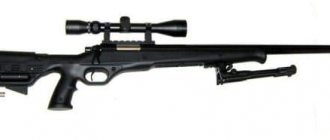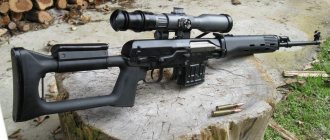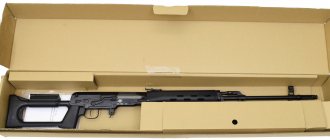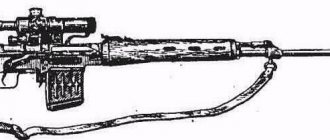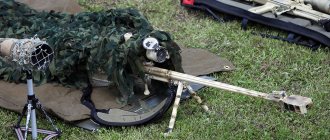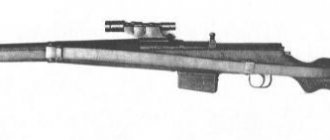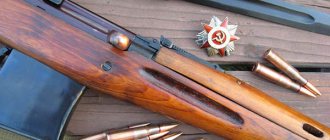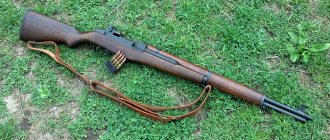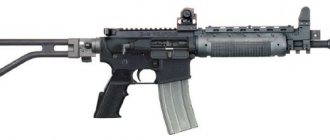The Dragunov rifle is perhaps the most famous example of a sniper weapon in the world.
For more than half a century since its adoption, the SVD has taken part in almost all military conflicts in the world. Four dozen countries have adopted the Dragunov rifle, collectors of the civilian arms market around the world are hunting for it, in the United States they are arguing about it, citing various arguments, both specialists and armchair analysts. And in how many films and games the elegant and thin SVD with its characteristic butt and wooden stock appeared - it’s difficult to list. The beloved and hated sniper (or “precision combat”) rifle - these are its characteristics, and today we are talking about the legendary SVD.
Legend replaces legend
When describing the SVD, it must immediately be said that the future legend has replaced another legend - the long-existing Mosin rifle in its sniper version. The battles of the late Great Patriotic War showed that the practice of using sniper versions of self-loading rifles - our SVT or the German Walther G-43 - was fully justified. In the hands of experienced fighters, such rifles become truly deadly weapons. The 309 killed Nazis from Lyudmila Pavlichenko’s SVT perfectly illustrate this thesis.
SVD scheme
Source: pinterest.ru
Nevertheless, the “self-loading” guns from the war did not meet the requirements for them, primarily in terms of simplicity and reliability. New weapon systems chambered for the 7.62x39 intermediate cartridge were less long-range, and the only non-automatic carbine chambered for this cartridge, the SKS, was not suitable for the role of a sniper. The upward extraction of the cartridge case and the insufficiently powerful cartridge, as well as the rapid displacement from the troops by faster-firing brothers - all this excluded the carbine from the list. Therefore, accurate shooters of motorized rifle companies continued to arm themselves with Mosin rifles. Of course, this could not continue; a big war that could happen would require new solutions in the field of creating precision weapons.
This solution was found by the hereditary Russian gunsmith Evgeniy Fedorovich Dragunov. During the war and immediately after its end, he worked in weapons production and by the end of the 50s he was already an experienced design engineer. He had several developments behind him, including the successful S-49 sporting rifle.
Soldier with SVD in Afghanistan
Source: pinterest.ru
The military had long felt the need for a new precision rifle, and in 1957 a competition for such a weapon was launched. Dragunov and his group of Izhevsk gunsmiths faced very serious competitors - the famous Simonov himself with his Klimovites and Konstantinov from Kovrov. All three rifles presented reached the finals, and in tough tests the future SVD came out on top.
"Three-line" and its entire family
The main types of small arms of the Red Army during the Great Patriotic War
The most popular military profession during the Second World War remained the traditional infantry specialty of a shooter. The Workers 'and Peasants' Red Army was no exception. A shooter with a conventional rifle bore the brunt of the battle. And therefore the fate of his weapon is especially interesting.
The pre-war small arms system of the Red Army was modern and fairly balanced in its nomenclature. But since it was formed mainly in 1939-1941, this led to the appearance of numerous samples within the same type. Thus, the magazine rifle mod. 1891/30, and a self-loading rifle mod. 1940 (SVT-40), chambered for one 7.62 mm rifle cartridge. In addition, each of them had a sniper version, and for ordinary soldiers of special forces - signalmen, sappers, etc. - a carbine mod. 1938
MILLIONS AND MILLIONS
Rifle mod. 1891/30 and carbine mod. 1938 were direct descendants of the Russian “three-line rifle” or, more precisely, the “3-line rifle mod. 1891”, created by an officer of the Tula Arms Factory S.I. Mosin (although elements developed by the Belgian gunsmith L. Nagan and members of the Commission of Major General N.I. Chagin were also used in its design). The definition of "three-line" simply meant the caliber measured in the inch system: 3 lines corresponded to 0.3 inches, that is, 7.62 mm. The Russian army then received three versions of the rifle - infantry, dragoon and Cossack. Since 1907, serial production of carbines for artillerymen and special forces began. And in 1908, a 7.62-mm rifle cartridge with a pointed bullet was adopted.
The modernization of 1930 included the installation of a new sighting device on the dragoon rifle (infantry and Cossack rifles were no longer produced by that time) and the introduction of some other changes to the design. Rifle mod. 1891/30 with a needle tetrahedral bayonet (the rifles were even brought into normal combat with the bayonet in the combat position) was considered a temporary solution - the main weapon of the Red Army was to become a self-loading rifle.
The order plan for the People's Commissariat of Armaments for 1940 provided for the production of 1,222,820 rifles mod. 1891/30, 163,000 carbines mod. 1938 and 600,000 self-loading rifles mod. 1938 (SVT-38). In 1941, due to the production of the SVT-40 modification, the order for self-loading rifles was reduced. But already at the beginning of 1941, the People's Commissariat of Defense significantly adjusted its requests, deciding to increase the number of self-loading rifles from 200,000 to a million, even with a complete refusal to supply repeating rifles.
The issue was considered by a special commission, and to understand its importance, just look at its composition: chairman - V. M. Molotov, members - G. M. Malenkov, N. A. Voznesensky, People's Commissar of Internal Affairs L. P. Beria, People's Commissar of Defense S.K. Timoshenko, Chief of the General Staff G.K. Zhukov. They spoke in favor of urgently increasing the production of high-tech vehicles. The then People's Commissar of Armaments B.L. Vannikov later recalled that he had to personally contact I.V. Stalin. He took into account the objections of the People's Commissariat and overturned the commission's decision. The order plan for 1941, approved on February 7, included 1,800,000 rifles: 1,100,000 self-loading and 700,000 magazine rifles. The production of “three-line guns” at the Tula Arms (No. 314) and Izhevsk (No. 74) factories has been preserved.
Repeating rifles and carbines were among the types of small arms with which the Red Army was provided, even in excess of its staff, by June 1941. But the difficult events of the initial period of the war: retreat, large combat losses, loss of weapons depots acutely raised the question of an urgent increase in the production of rifles. The good old “three-line” was 2.5 times cheaper in production than the new and still insufficiently mastered SVT, and it was also faster and easier for soldiers to understand. It is not surprising that it is the rifle mod. 1891/30 became the main weapon of the Red Army in battles with the Germans and their allies. It is worth noting that repeating rifles and carbines were the most popular weapons in other armies throughout the Second World War.
At the beginning of the Great Patriotic War, the “three-line” was modernized - primarily to simplify production. The receiver was made without top edges, the brass parts of the device were replaced with steel ones, the finishing was simplified, and the stock was not polished. Since the First World War, for simplicity, the rifle belt was attached to slots in the butt and fore-end of the rifle, which served as swivels (hence, by the way, the famous joke: “How much does a rifle swivel weigh?”). But now we had to simplify the design of these slots. The Artillery Museum in St. Petersburg, for example, houses a rifle manufactured in Izhevsk in 1942. Its metal parts are roughly processed on the outside, the birch stock is impregnated but not varnished, and the slots in the stock for the belt do not have reinforcing “eyes.”
By the way, after the evacuation of Tula Plant No. 314, the main burden of supplying the army with repeating rifles fell on Izhevsk Plant No. 74. It received the task of increasing the production of “three-line rifles” to 12 thousand units per day! The implementation of the plan was facilitated by the transition, begun on the eve of the war, to making rifling in the barrel bore by mandrel (punching) instead of cutting and the organization of production taking into account the inevitable decline in the average qualifications of workers. Thus, not only the manufacture of parts and assembly of rifles, but also acceptance was divided into separate, easier to master operations.
We had to resort to old stocks. V. N. Novikov, who was at that time Deputy People's Commissar of Armaments, said that when a critical situation with receivers arose at the Izhevsk enterprise, the head of the quality control department remembered that since pre-revolutionary times, “in the old basements of the plant there are at least sixty thousand ready-made receivers ", which were rejected at one time due to deviations in size. After testing and corrections, these boxes were used for new rifles. Unless the military acceptance office asked to polish off the mark with the royal eagle.
In total, during the years 1941-1945, the Red Army and other military formations of the USSR received 12,139,300 repeating rifles and carbines (for comparison: in Germany from 1939 to 1945, 10,327,800 were manufactured). Maximum production and supplies were reached already in 1942, and in 1943, due to the gradual saturation of troops with weapons, the supply of rifles began to decrease. But it was then that the last combat model in the “three-line” family appeared.
TAKEN INTO ACCOUNT OF COMBAT EXPERIENCE
The preference for close combat, the need to operate in dugouts, communication passages, buildings, forests, overcoming obstacles and obstacles, and the participation of riflemen in tank landings and assault groups required lighter and more compact weapons than the “three-line.” It could have been the same carbine mod. 1938, because the intermediate power cartridge was just being developed and automatic weapons for it had not yet been designed.
But the carbine did not provide for mounting a bayonet. And it gave the soldier great confidence in close combat, and they were by no means going to give it up.
In May 1943, eight bayonet designs were tested (carbines with a detachable bayonet mount were also tested). By decree of the State Defense Committee of January 17, 1944, the 7.62-mm carbine mod. 1944 with a permanently folding Semin bayonet. It became the last mass-produced military weapon in the “three-line” family. The same decree removed the rifle mod. 1891/30. In the report of the head of the Artillery Supply Department of the 2nd Ukrainian Front, Major General Rozhkov dated August 7, 1944, it is said: “The accuracy and accuracy of the battle of carbines with an integral bayonet are fully consistent with the tactical and combat requirements of modern combat... The effectiveness of firing from a carbine with integral bayonet mod. 1944 at a distance of 300-400 m is the same as from a rifle mod. 1891/30." A few words about why such short distances were mentioned.
The experience of the war forced us to significantly reconsider the requirements for small arms. The trend towards precision shooting at long ranges has been replaced by the reverse installation. The infantry combat manual of 1942, which systematized the experience of the first period of the Great Patriotic War, stated: “The rifle is the shooter’s main weapon for hitting the enemy with a bullet, bayonet and butt... Concentrated aimed fire from a rifle is used to hit group targets up to 1000 m. Fire is carried out on airplanes and paratroopers up to 500 m, along the viewing slots of tanks and armored vehicles - up to 200 m.”
The most advantageous opening fire distance according to the regulations was 600 m for excellent shooters, and for all others - 400 m, that is, within the range of a direct shot. The determination of these values contributed to the development of an intermediate power cartridge and weapons for it. And when formulating the requirements for the new cartridge, we used indicators of the direct shot range of the carbine mod. 1944 So the “three-line” made its contribution to the formation of a new generation of small arms.
The system of training shooters was also revised. A number of commanders noted the excessive enthusiasm of the best Red Army soldiers on the eve of the war for “well-aimed” fire at targets, which was more of a sporting interest. When training mass shooters during the war years, they began to pay attention not only to the basics of accurate shooting, but also to the skill of loading a magazine and chambering a cartridge “blindly” - without taking their eyes off the target, to the ability to recognize and eliminate (if possible) the causes delays in shooting, choose a position.
Lieutenant General N.I. Biryukov wrote in his memoirs “The Hard Science of Victory” about how already in front conditions it was necessary to train riflemen to conduct aimed fire: “Any combat commander knows how much trouble young soldiers who are afraid of the sound of a shot bring. Here is a fighter lying on the firing line. He had mastered the theory of shooting well: you need to align the sight slot and the front sight, hold your breath, and smoothly press the trigger. But just as he was getting settled, his neighbor’s rifle rattled to the right, he flinched, and the target moved to the side. Now let’s imagine the same soldier when artillery shells whistle above him and explode somewhere ahead, when tanks roll over a trench and rush to attack... Nothing brings a soldier closer to a front-line situation than a tactical exercise with live fire. More than once I had the opportunity to observe in battle people who had previously been “baptized” in the rear. A huge difference compared to those who have not gone through such training.”
The “Three Line” became the basis for a sniper rifle, rifle grenade launchers using muzzle mortars or ramrod grenades, as well as one of the first mass-used types of special-purpose weapons. More precisely, “weapons of silent and flameless shooting.” For this purpose, a removable muzzle device “Bramit” (MITIN BROTHERS - named after the developers of the device) was used in combination with a special cartridge with a powder charge reduced by more than five times, which made it possible to reduce the initial speed of the bullet, which now did not exceed the speed of sound. “Bramit” was a muffler with two expansion chambers, a cut-off valve and holes for releasing gases. It was used by partisans, groups and special forces of the GRU and NKVD/NKGB. A carbine with a Bramit device, for example, was considered as an option to eliminate the Gauleiter of Belarus Wilhelm Kube in 1943, although the option with a time mine was implemented.
After the war, the sniper rifle remained the longest of the three-line family in military service - until the appearance of the Dragunov sniper rifle in the army.
NOT JUST TROPHIES...
Although the “three-line” rifle in various versions was the most popular rifle, it did not remain the only one. In the summer and autumn of 1941, a large number of rifles of various calibers and systems ended up, for example, in parts of the people's militia. Sometimes they are classified as captured, which is true if we talk about the Austrian 8-mm rifles and carbines “Mannlicher” system of 1895, which were actually captured from the enemy during the First World War, or the 7.92-mm “Mauser” wz.1929 , captured in the fall of 1939 in Western Ukraine and Western Belarus.
Let me remind you that while Russia was participating in the First World War, it purchased a large number of different rifles and cartridges from its then allies. Russian troops received French rifles Lebel, Gras, Gras-Kropachek, Italian Vetterli-Vitali, Japanese Arisaka. A significant part of them were preserved in warehouses and were removed from there in the summer and autumn of 1941.
Therefore, it is not surprising that the departmental formations of the People's Commissariat of the Fuel Industry had rifles of the Lee-Enfield 1914, Arisak 1905, Lebel 1907/1915/1916, Mannlicher 1893, Vetterli-Vitali 1870/1884, Gra-Kropachek 1874/1885 rifles years and 1885, 1878/1884. Rifles of the Arisaka system mod. 1905, along with other foreign weapons, fighters of the fighter battalion of the Leningrad Baltic Plant received Lebel rifles - the militia of the Krasnogvardeisky district of Moscow.
Interesting are the memories of one of the veterans of the Great Patriotic War, who began his combat career in the Moscow militia, about the issued French rifles: “We almost caught wires with them.” Indeed, French needle stiletto bayonets were very long.
Despite the saturation of the troops with weapons, they had to resort to using new trophies at the front. Mainly for arming units of engineering troops, communications troops, that is, “support units.” Thus, the documents of the 123rd separate motorized pontoon-bridge battalion indicate that when repelling an enemy raid on July 17, 1943, “1291 pieces of Italian cartridges” were used up. The use of Italian rifles (we are obviously talking about captured Mannlicher-Carcano rifles) is not surprising - back in March 1943, this battalion had about half of the 318 rifles allotted to it.
The use of captured weapons in the presence of ammunition was not uncommon. It is no coincidence that NKO Order No. 6 of January 5, 1943 indicated: “... captured weapons and property taken by troops during the battle and immediately used in battles against the enemy remain in the troops.”
HERR "MAUSER"
Here the question inevitably arises about comparing the domestic rifle with the most popular enemy weapons. These, contrary to the stereotype ingrained in the minds of the majority, were repeating rifles and carbines of the Mauser system of 1898, and not MP38 submachine guns.
Most Wehrmacht units had the Mauser K98k carbines (or shortened rifles) adopted in 1935, although old infantry rifles and Mausers of Czech, Belgian, Polish, and Austrian production were also used. According to the combat characteristics of the rifle mod. 1891/30 and K98k were equivalent. And yet each had its own characteristics.
The Russian “three-ruler” remained its remarkable ease of use and high reliability. But without in any way detracting from the merits of the domestic model, it must be admitted that it is the Mauser of 1898 that is considered a classic of military repeating rifles.
Its positive qualities include the features of the shutter, trigger mechanism, magazine and stock. A non-automatic safety lever with three positions is mounted in the rear part of the bolt: locking the hammer with the hammer and the bolt, locking the hammer with the hammer (used only when disassembling the rifle) and “fire”. The “three-line” does not have a fuse. True, pulling back the trigger, screwed onto the back of the firing pin, with a quarter turn can be considered putting the weapon “on safety,” but such an operation required a lot of effort and contributed to weakening the mainspring.
The Mauser’s trigger mechanism provides a “warning” release, which facilitates more accurate shooting than the “three-ruler” trigger without warning, although this does not play a significant role for a mass shooter in battle. The advantages of the Mauser's two-row magazine are obvious. Its appearance was facilitated by a German cartridge without a protruding rim and with a sleeve fixed in the chamber by the front slope. The Russian three-line cartridge was fixed with a protruding rim, which determined the use of a single-row magazine and the appearance of a cut-off reflector in the “three-line” - one of the key elements of the Mosin system. The K98k stock with a semi-pistol protrusion of the butt neck provides comfortable aiming; the butt neck is somewhat stronger than that of the “three-ruler”.
The advantages of the Mauser K98k design are the result not so much of the talent of the creators as of the history of development. The Mauser system took ten years to develop before being put into service. The “three-line” system was created earlier and in a shorter time. The end of the 19th century, when both systems appeared, became the beginning of a new era in the history of small arms - the era of cartridges with smokeless powder and new ballistics, an increase in the rate of fire. And even a seven-year difference in such turbulent periods means a lot. The “Three Line” was subsequently modified slightly, mainly due to the adoption of a new version of the cartridge or to simplify production. Moreover, on the eve of both world wars in our country they intended to soon replace it with a self-loading rifle.
During the war, German industry also faced the need to reduce the cost of weapons production. In particular, on the K98k, the walnut wood of the stock was replaced by cheaper wood or plywood board, a number of parts were made by stamping, magazine boxes were made of tin, stock rings were simplified, and “ersatz bayonets” were introduced.
Reliability and accuracy as two mutually exclusive
The SVD is unique primarily in that its design, performance characteristics, and mission included extremely complex requirements. In fact, they were mutually exclusive for this class of weapon. This is how Evgeniy Fedorovich himself recalled:
“When designing, we had to overcome a number of contradictions. For example, for a rifle to operate reliably in difficult conditions, it needs to have large gaps between moving parts, and in order to have better accuracy, everything needs to fit as tightly as possible.”
SVD with a modern sight
Source: pinterest.ru
The best thing about this story is that Dragunov managed to combine these requirements. Many believe that the SVD does not stand out in any way in terms of design solutions. This is true - no original inventions, everything is simple and tested. Similarity to AK in design is another myth. It is enough to disassemble the SVD and look at the bolt group and piston to understand the inconsistency of the myth. During operation, it turned out that it was better to reduce the pitch of the rifling in the barrel, which was done. Thus, an SVD with a standard PSO-1 sight puts a bullet in a 12 cm circle from a distance of 300 meters. And this is quite acceptable accuracy for a general-arms precision rifle.
SVDK
Source: pinterest.ru
Interestingly, the SVD became the world's first(!) self-loading general-arms precision rifle of a special design. This determines all its advantages and disadvantages. Disadvantages include, for example, the lack of a bipod. But... Firstly, this can be easily treated with modern tuning, and secondly, there was no such task. However, all the main discussions around the SVD boil down to commentators’ ignorance of the technical requirements when designing a rifle.
